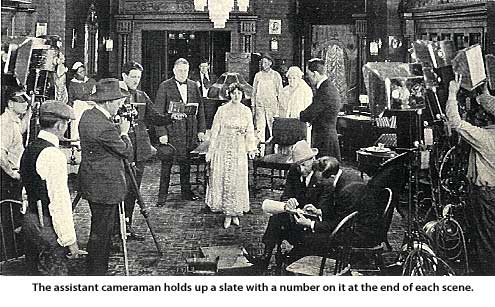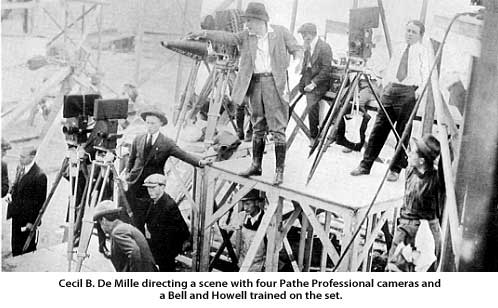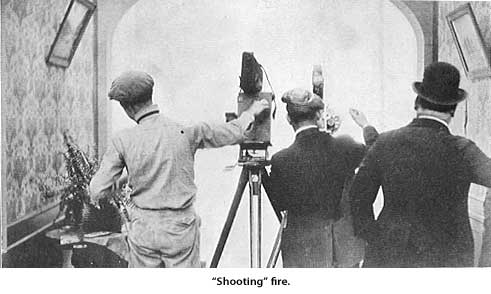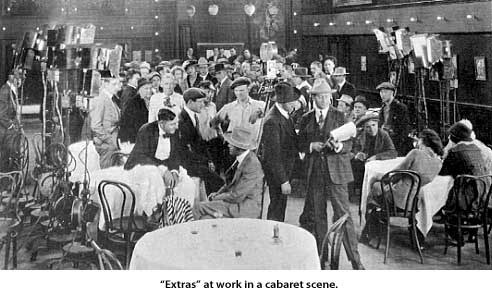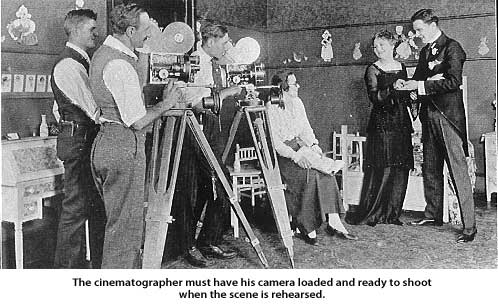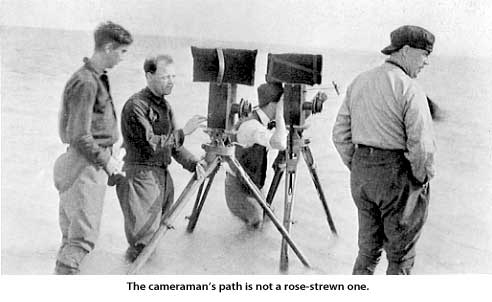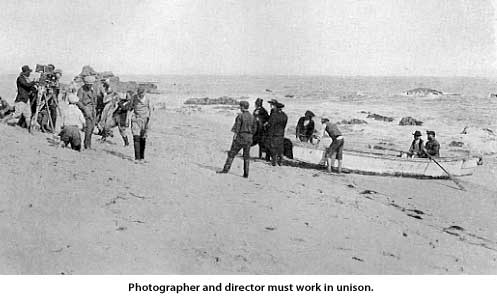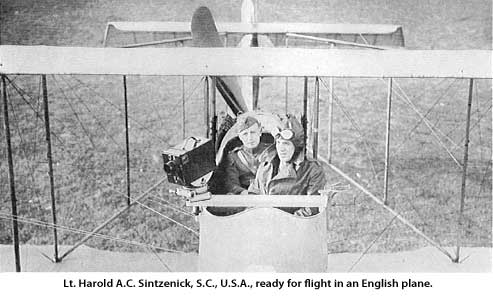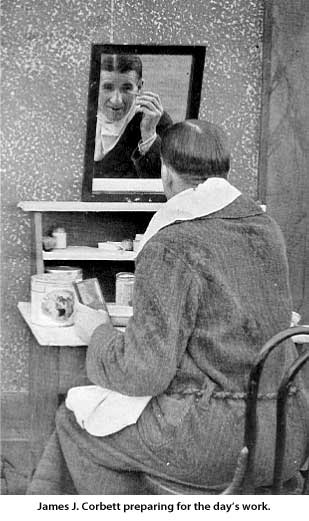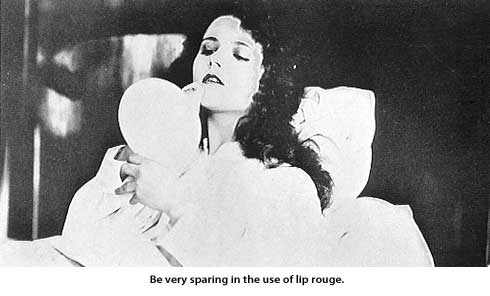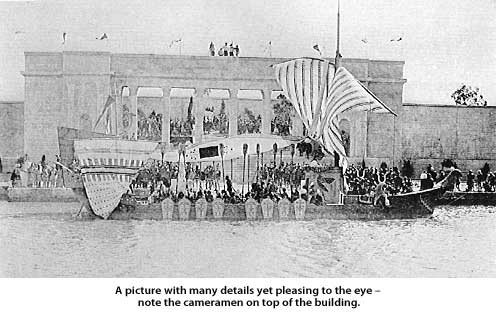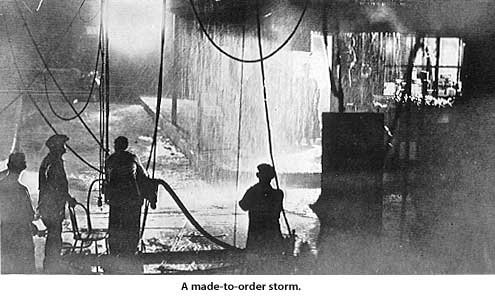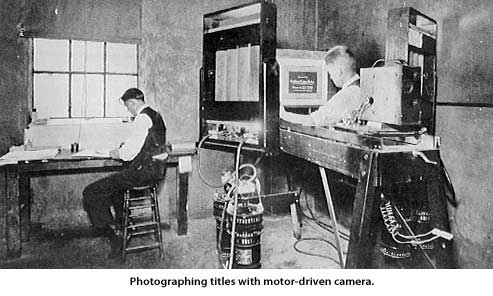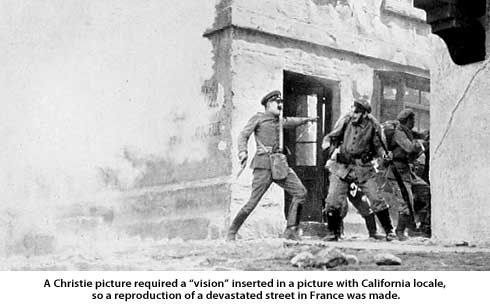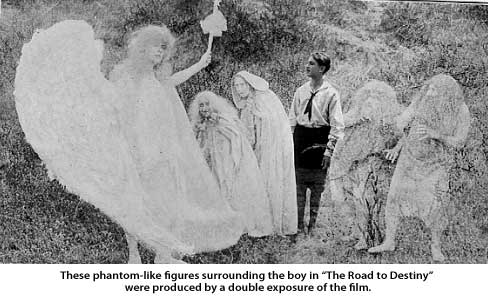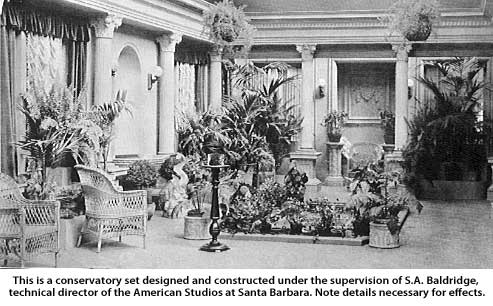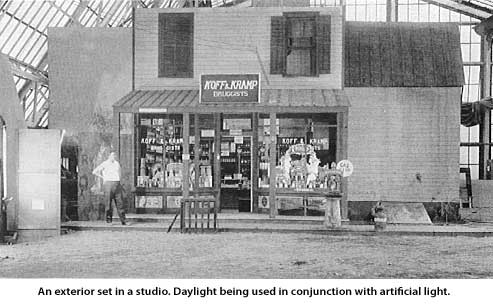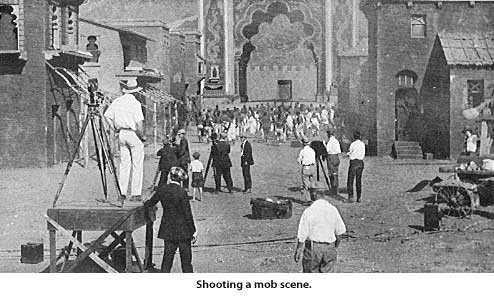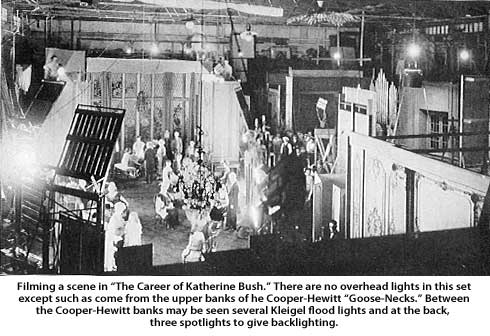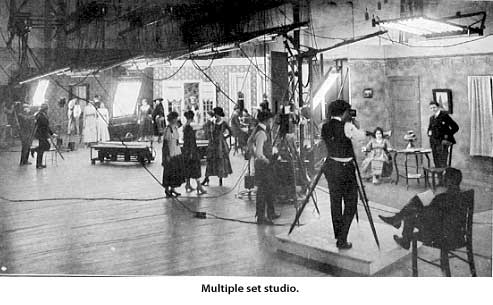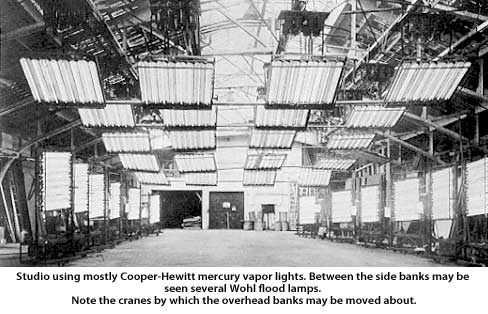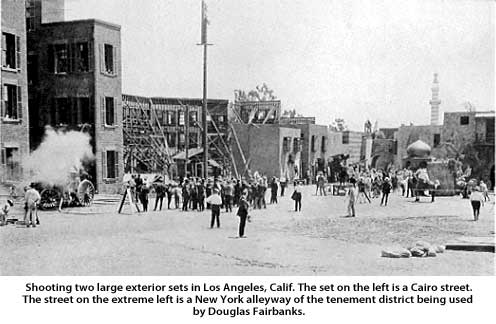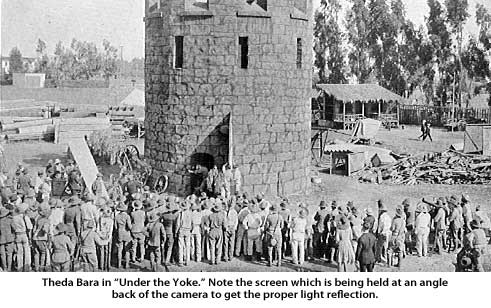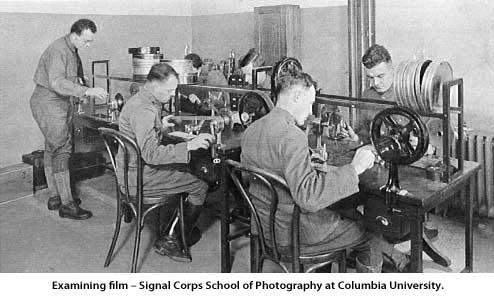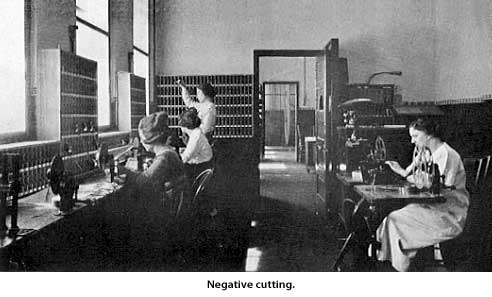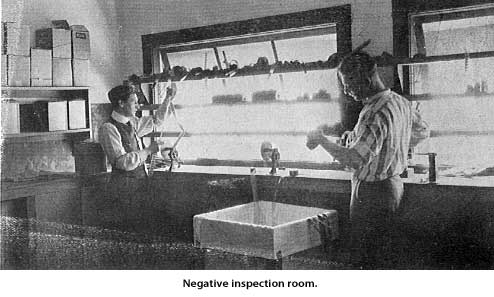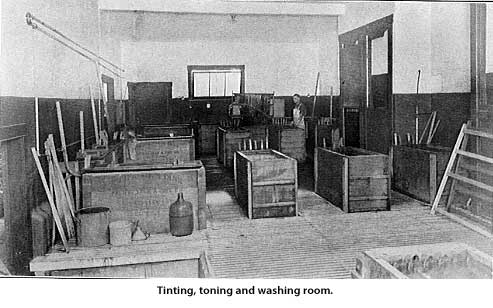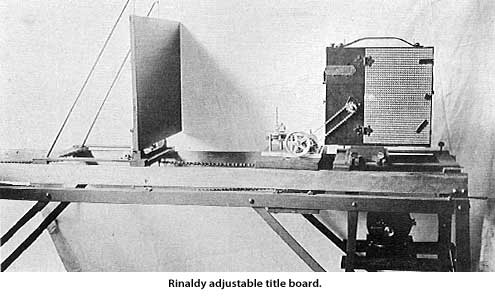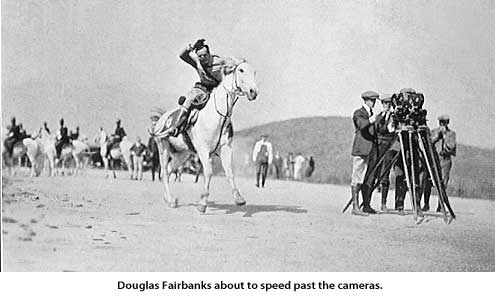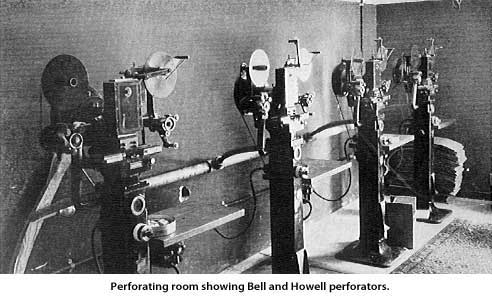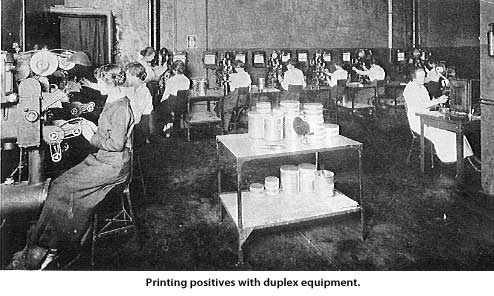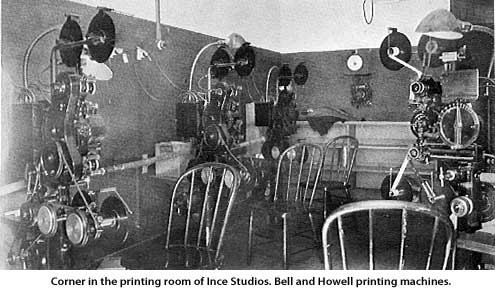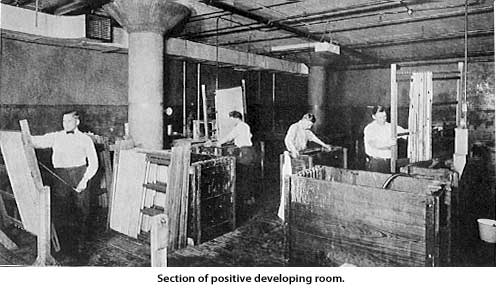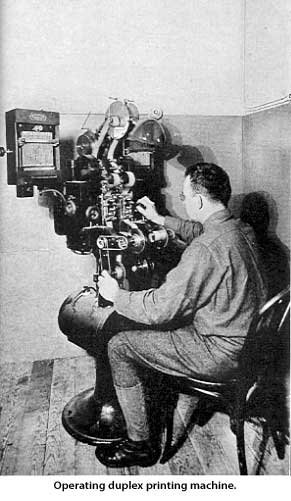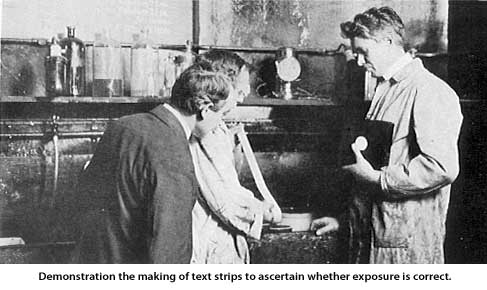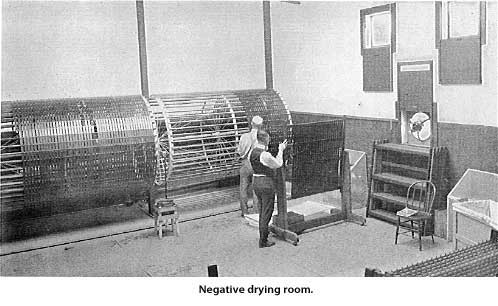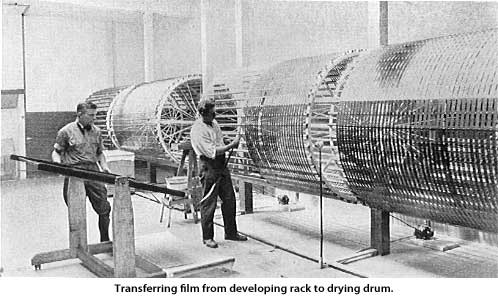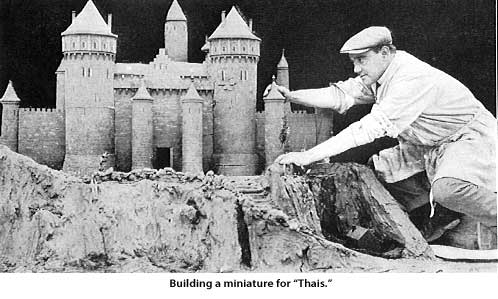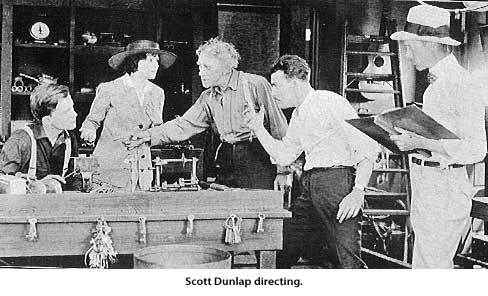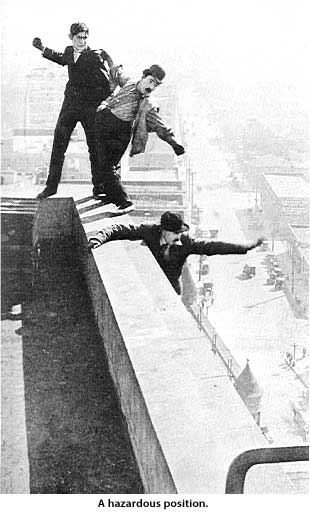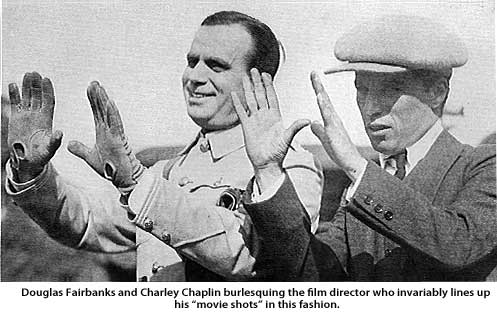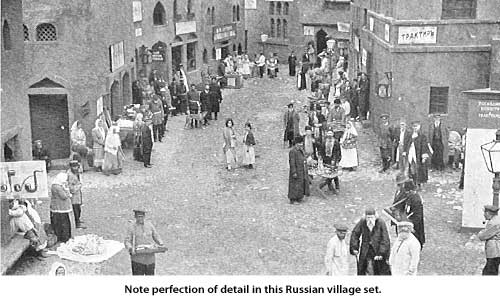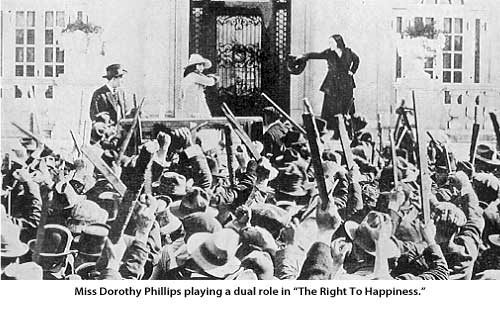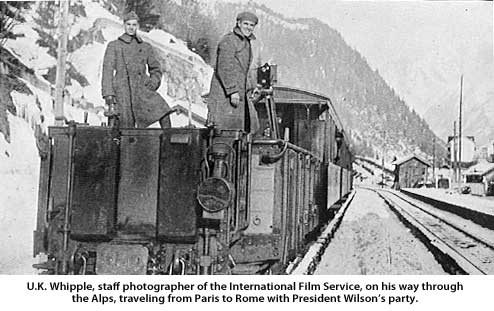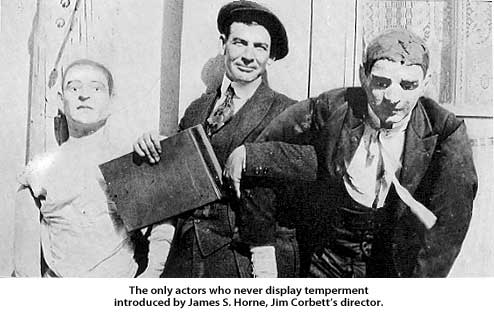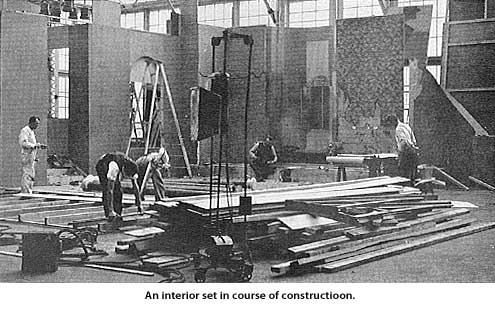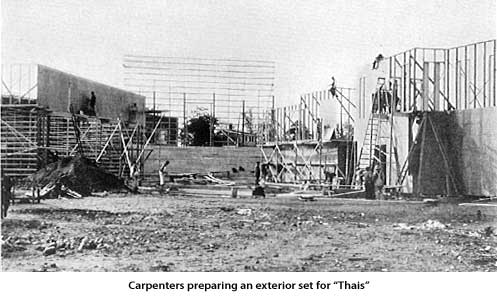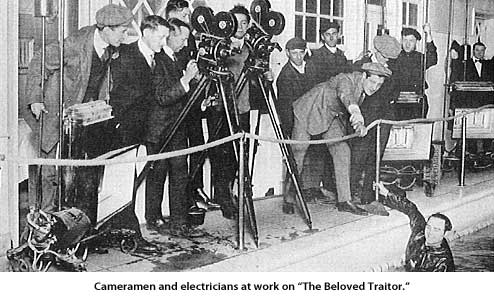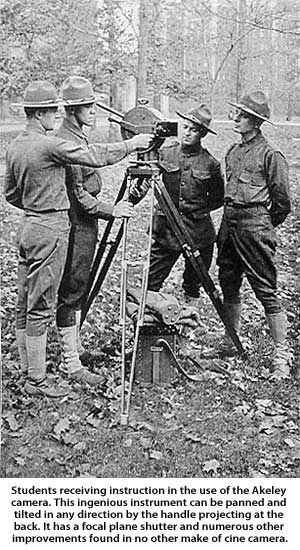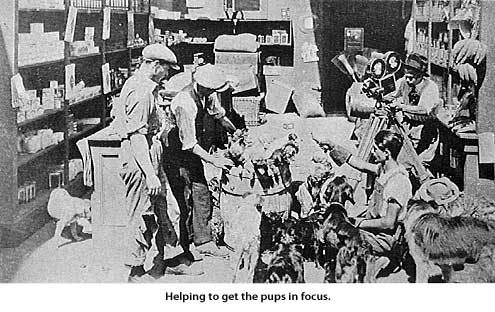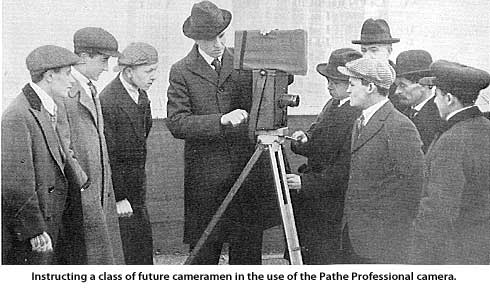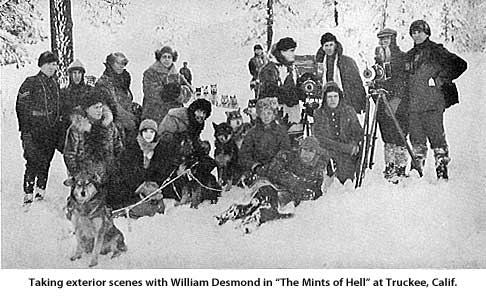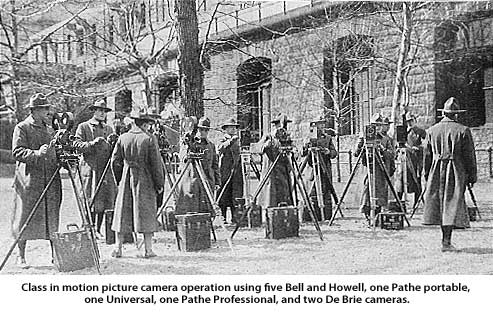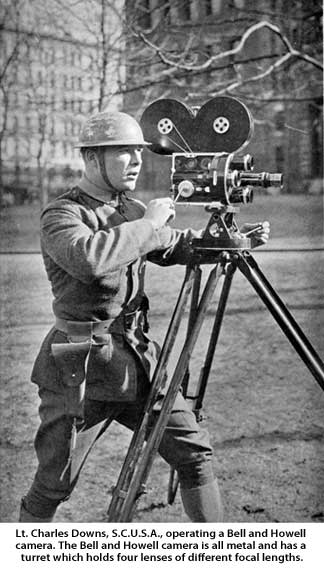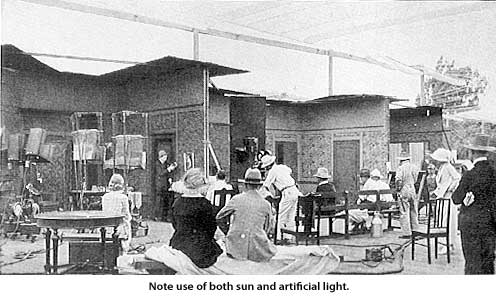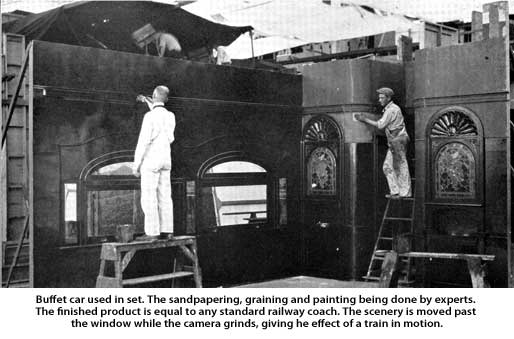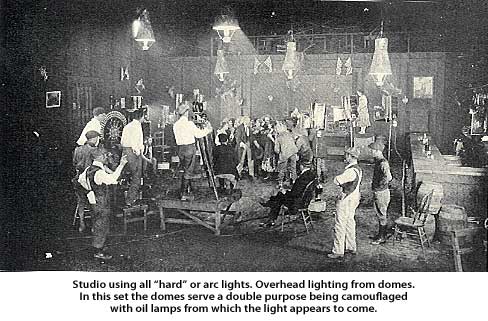This article reveals a unique view of filmmaking in the 1920’s, as it focuses on the history of moving pictures from the perspective of an era long passed. The accompanying photographs reveal the troublesome but energized beginnings of the film industry. The source book may be available in some libraries. These photos may not be copied or used without permission.
Condensed Course in Motion Picture Photography edited by Carl Louis Gregory, F.R.P.S
Chapter 1 – HISTORY of CINEMATOGRAPHY
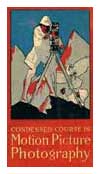
Pages 7-18: It is not impossible that some form of motion pictures was known to the Ancients. Titus Lucretius Carus wrote several volumes entitled “De Rerum Natura” at least 75 years before the Christian Era, wherein book four, verse seven hundred sixty-six, appears the following freely translated: “Do not think thou moreover wonder that the images appear to move and appear in one order and time their legs and arms to use for one disappearance, and instead of it appears another arranged in another way, and now appears each gesture to alter, for you must understand that this takes place in the quickest time.”
In the year A.D. 130, Ptolemy, a Greek philosopher, wrote a series of books on optics, in which he not only described the phenomenon on persistence of version, but also described a piece of apparatus in the form of a revolving disk with spots on it, which demonstrated this phenomenon. Persistence of vision is a scientific term for the fact that the sensation of light coming from an object remains in the brain for an appreciable fraction of a second after the light has been extinguished. Whatever knowledge the Ancients may have possessed of motion pictures is too remote and too far buried in the murky depths of the past to be of more than momentary interest in the history of cinematography.
The first step toward modern cinematography took place about the year 1833, when W. G. Horner patented the Zoetrope, or Wheel of Life, which consists of a hollow cylinder turning on a vertical axis and having its surface pierced with a number of slots around the interior. Between the slots is a series of pictures representing successive stages of such a subject as a galloping horse, and when the cylinder is rotated, and observes looking through the slots as the wheel is rotated sees the horse apparently in motion. The pictures were drawn by hand, but photography many years afterwards was applied for their production. This did not occur until about the year 1877.
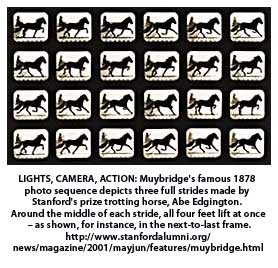
About the year 1872, Edward Muybridge, and Englishman employed in the United States Geodetic Survey, made photographs of a racehorse in motion. Muybridge made these at the instance of several racehorse owners, who had come to a hot discussion regarding the gait and mode of locomotion of their favorite steeds. Muybridge set up his camera with wet collodion plates (dry plate did not come into general use until sometime later) and made snapshots of racehorses at the Sacramento racetrack. A few trials demonstrated that unless he could show rapid successive pictures of the horses in motion he could not settle the dispute. The contestants made up a fund with which he purchased twenty-four cameras and placed them at the edge of the race course, close together in a row with a fine thread attached to the shutter of each camera and stretched across the racetrack, so that the horse in passing would break the thread and release the shutter of the camera, and thus make an exposure upon the sensitized plate. Each successive camera passed would then show a slight advance in action, with the result that by the time the animal had passed in front of the twenty-four cameras, he would leave a fairly accurate record, which could be studied at leisure. The first results were not very satisfactory, as the sensitiveness of the collodion plates was not sufficient to get pictures in the small fraction of a second required to stop the motion. To overcome this obstacle, a fence was built at the side of the track in front of the cameras and painted black. If the horse being studied was not white, lines were drawn upon its limbs in white paint, so that with the help of the brilliant California sun, sharp well-defined silhouettes could be made at a much greater speed than had hitherto been possible.
Leland Stanford, Governor of California at that time, and an enthusiastic horseman himself, became very much interested in Muybridge’s experiments. Governor Stanford was a wealthy man and furnished him with funds, to continue his animal study. A studio was built at the Governor’s private racetrack in Palo Alto, where Leland Stanford University now stands, and in this studio were place the twenty-four cameras. Here it was that Muybridge conducted the major part of his experiments. Having succeeded in analyzing animal motion, he now proceeded to synthesize his results; or, in other words, to reproduce the movements of the animal so that they would be visible to the eye. He finally produced a machine, which would project the images of the glass plate upon a screen. He called this machine the Zoopraxoscope, probably with the intention of setting a record for a double-jointed polysyllabic word, which many others have tried to outdo. C. Francis Jenkins, in one of the first volumes ever published about motion pictures, gives a list of over a hundred coined words, which have been applied to motion pictures of which practically the only surviving one is Cinematography. Some of them were: Symographoscope, Chronomatograph, Chronophorographoscope, Photokinematoscope, Phantasmagoria and Getthemoneygraph.
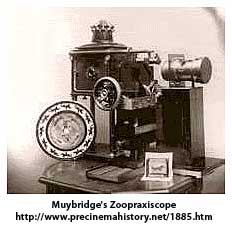
The Zoopraxoscope consisted of a large glass disk, with the reproductions of the photographs set along its margin. A limelight was set up with a condensing lens, which would project the picture on a screen. This glass disk revolved continuously and the images on the screen were naturally blurred by this movement. However, the introduction of a shutter allowed the light to pass through each successive picture for a very short interval as each image came into place. These rapidly succeeding pictures produced the first moving picture on a screen.vIt is interesting to note that in 1860, twelve years before Muybridge commenced his brilliant experiments, the production of motion pictures by photographic men had already occupied the attention of scientists.
Sire john Herschel, the celebrated astronomer, who was also a brilliant chemist, foretold nearly sixty years ago the method used today in making motion pictures. It was he, who in 1819 discovered the solvent power of hyposulphite of soda on the haloid salts of silver, thus introducing it as a fixing agent in photography. His prediction of motion pictures was published in 1860 in the Photographic News, a leading journal of photography at that time. He says: “What I have to propose may seem to you like a dream, but it has, at least, the merit of being possible and indeed at some time realizable. Realizable – that is to say, by an adequate sacrifice of time, trouble, mechanism and outlay. It is the representation of scenes in action by photography.
The vivid and life-like reproduction, and handing down to the latest posterity of any transaction in real life, a battle scene, a debate, a public solemnity, a pugilistic conflict (Heenan and Sayers prize fight took place 1860), a harvest home, a launch – indeed, anything, in short, where any matter of interest in enacted within a reasonably brief time, which may be seen from a single point of view.
I take for granted nothing more than – first, what photography has already realized or what we may be sure it will realize within some very limited lapse of time from the present date – viz., the possibility of taking a photograph instantaneously, of securing pictures in a tenth of a second; secondly, that a mechanism is possible, no matter how complex or costly – and perhaps it need not be either the one or the other – by which a prepared plate may be presented, focused, impressed, displaced, numbered, secured in the dark and replaced by another within two or three-tenth seconds.
In fact the dismounting and replacing need only be performed within this interval; the other items of the process, however numerous, following these up in succession, and collectively spreading over as long a time as may be needful.
There is a pretty toy called the phenakistoscope, which presents a succession of pictures to the eye, by placing them on a wheel behind a screen, and bringing each in succession to an opening in the screen of the size of the picture and thus allowing it to be seen. The eye is in like manner covered by a dark revolving screen, having narrow linear openings in it that allow glimpses through them precisely at and only at the instant when the pictures are in the act of transmitting the frame, and sensibly in the middle of the area.
By this arrangement it has been found possible to exhibit figures in action, as dancers pirouetting, wheels revolving, etc., by having prepared a set of figures taken from one model presented at various angles to the visual ray.
Coarse as the representations so made have been, the apparent reality of movements has been very striking. The persistence of the impression on the retina and its gradual fading obliterates, or glosses over, the hiatus in a way that would hardly be thought possible. Now there is nothing in the law of periodicity as regards the movements of the model, to influence the results, and we have only to substitute for such a periodically recurrent set of pictures imperfectly drawn by hand, perfect stereoscopic and simultaneous pairs of photographs duly presented to both eyes, in their natural order of succession to produce a stereoscopic picture in action.
In 1878, Muybridge published the results of his experiments, which excited great interest in this country and in Europe; particularly among artists who had always been puzzled as to the correct attitude assumed by animals in locomotion. As soon as the results of Muybridge’s experiments were published, demands came for him appear before various scientific bodies to demonstrate his discoveries. His first appearance in Europe was in the laboratory of Dr. E. J. Marey in 1881, where he lectured to some of the foremost savants of France. Dr. Marey, himself, was intensely interested and established a studio for investigation of the motion of animals by similar photographic methods. He had already invented an instrument called the Marey Photographic Gun, which was shaped somewhat like a monster revolver and took twelve quickly successive images of a moving object, recording them upon a circular sensitive surface.
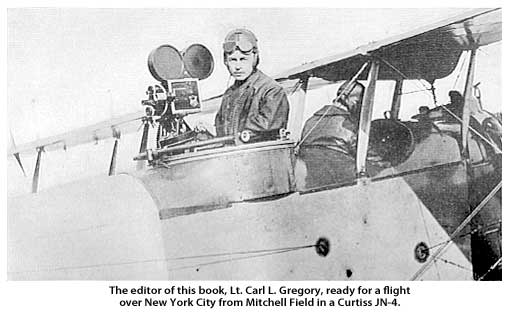
When Mauybridge returned to this country, the University of Pennsylvania offered to equip a studio for him and furnish funds for carrying on his investigations. The studio, one-hundred-and-twenty feet long, was built on what is now known as “The Hamilton Walk” on the University campus. To carry his work much farther, he had to find a method of getting quicker exposures. He determined to solve the problem and achieved marvelous results, making many advances in the science of Photography. So well did he succeed that some of his photographs are unexcelled at the present day, many of them having been taken in the one-sixth thousandth part of a second.
In 1887, Muybridge, in collaboration with Dr. Edward Reichert, professor of Physiology at the University, made the first instantaneous pictures in medical research. A dog was given an anesthetic, its chest opened, and the successive phases of the dilation and contraction of the heart were photographed. Thus the first motion picture record displaying the movements of any internal organs – human or animal – was made.
In February 1888, Muybridge went to Thomas A. Edison, the inventor of the phonograph, and asked if his zoopraxoscope and the phonograph could not be synchronized so as to give the simulation of people speaking. Edison had not yet perfected the phonograph so that it was loud enough to be heard by a large audience and therefore could not consider the project at that time.
Muybridge published a book, “Animals in Motion”, which is now used by artists in their studios, so that they may correctly delineate their subjects. It has proven a mine of information to those who produce animated cartoons and diagrams.
In 1893, at the Chicago World’s Fair, Muybridge exhibited more than twenty thousand original photographs in his machine for showing them. In recognition of this the commission of the Exposition awarded him a certificate of honor. This marked the practical completion of Muybridge’s work, as he was then an old man. He devoted more than twenty years of his riper maturity to the advancement of pictured motion. It is true that compared with the motion picture of today, his results were crude but they were pictures in motion nevertheless and he is honored and respected as the father of Motion Pictures.
Inspired by the work of Muybridge, many other investigators sought to produce the simulation of life upon the screen. Dr. E. J. Marey of Paris was the most prominent of these. In 1890, he first used the celluloid roll film, which had just been given to the world through the efforts of the Rev. Hannibal Goodwin and George Eastman. Even before this, others had made partially successful attempts at using a flexible support for producing successive pictures from a single viewpoint. As presented by Muybridge with his twenty-four cameras, the result achieved was the same as the modern device of moving a motion camera in an automobile or on a moving truck, traveling at the same speed as the object photographed – in other words, the object on the screen remained stationary, while the background moved past like a panorama.
Dr. Marey decided that the pictures must be taken from one point of view and applied himself to perfecting a camera, which would take photographs in rapid succession from the same viewpoint. In this he was successful, but, on account of the limitations imposed by the weight of glass plates, was unable to take more than a relatively small number of pictures at one time. Not only did the employment of glass slides require very elaborate mechanism, but the quantity of glass necessary prohibited the showing of more than a few short phases of action.
In 1876, Wordsworth Donisthorpe patented a mechanism for making photographson a deck of glass plated, like a deck of cards pushed to the focus of the lens and exposed, one at a time, then dropped down and out of the way of the next plate, at the rate of eight exposures per second. In his patent he makes this claim, If the apparatus be arranged to take successive pictures at sufficiently short intervals of time, they may be printed at equal distances upon a continuous strip of paper. This paper, with the series of pictures upon it, may be used in the instrument known as the Zoopraxoscope, or Wheel of Life. To allow of this, the strip of paper may be wound on a cylinder to be unwound from it, at a uniform speed, unto another cylinder, and so carried past the eye of the observer, any ordinary means being used for any showing that each picture shall be exposed momentarily to the observer. By this means, the movement made by a person or group of persons, or of any other objects during the time they were being photographed, may be reproduced to the eye of the observer.” With this apparatus he photographed and reproduced growing grass, buds developing into flowers, and the metamorphosis of frogs. Thus he was the first to take “stop motion” pictures.
The period from 1889 to 1893 might be termed the gestation period of what we still love to term our infant industry.
The invention of the motion picture is ascribed by many to Thomas A. Edison, but so many other scientific men were busily engaged in trying to solve the problem of producing motion pictures in a commercial way at this time, that it is difficult and probably unjust to give the credit entirely to any one man.
Dr. Marey, so far as I know, was the first to use the flexible sheet celluloid, but it is probably that the same instant that Dr. Marey was carrying on his experiments in Paris, W. Friese Greene and M. Evans were using paper film for the very same purpose in England. In 1899, they filed application for patent on a machine for taking and projecting moving photography by means of a ribbon of successive photographs. On the other hand, a brochure published in 1895, and bearing Edison’s entire endorsement, lays claim to his being the prior inventor as follows:
In the year 1887, Mr. Edison found himself in possession of one of those breathing spells, which relieved the tension of inventive thought. It was then that he was struck with the idea of producing on the eye the effect of motion by means of a swift and graded succession of photographs. The initial principles of moving images were suggested to him by a toy, the Zoopraxoscope, or Wheel of Life. It was determined to revolutionize the whole nature of the proceedings, by instituting a series of impressions fixed to the outer edges of a swiftly rotating disk supplied with a number of pegs, so as to project from under each picture on the rim. A Geissler tube was placed, connected with an induction coil, which, operated by the pegs, lighted up the tube at the precise moment when the picture crossed its range of vision.
Curiously enough, during all of this period, when men like Marey, Edison, Evans, Demeny, Donishthorpe, Jenkins, Anchuetz, and many others were working upon the problem of photographing pictures in rapid succession, very little attention was paid to the problem of projection, because their ideas were centered upon the use of the pictures for individual observers in coin operated slot machines. Although a number of the patent specifications include the use of the camera mechanism, or a similar mechanism for purposes of projection, very little actual work seems to have been done toward solving the problem of presenting motion pictures to a multiple audience. Numerous authentic examples of motion pictures taken by various inventors at this period are in existence today, but it is probably that the first public exhibition to an assembly of people was given by C. Francis Jenkins on June 6th, 1894, in his father’s shop at Richmond, Indiana. Jenkins was at that time a stenographer in the treasury department at Washington, D.C., and, in his spare time had been experimenting in the making of motion pictures.
Jenkins writes of his first inception of interest in the subject as follows:
In 1885, while standing one day on a high prominence in the Cascade Mountains, I watched the reflections of sunlight from the axes of some working men clearing the right of way for a railroad in the valley below. The reflection from two or three hundred axes produced a peculiar scintillating and beautiful effect. From that moment I date all of my efforts to achieve what finally resulted in the perfection of the chronophotographic apparatus I have built and used.
My experimentation was dependent upon what could be spared out of a small salary. This is my excuse for the delay in completing a commercial machine after the first conception of the phantoscope, which is simply a fanciful name for the various devices I have employed in this work – the different steps of which may readily be followed by an inspection of the old apparatus now on exhibition in the United States National Museum.
My active efforts were begun in 1890. Of course, first of all pictures were to be secured. The first apparatus built for this purpose consisted of a ratchet-rotated drum, upon which the film was wound to feed it past the point of exposure. The camera made a succession of pictures upon this film by short exposures – the film being jerked forward the width of one picture in the interim. Two shutters were supplied – one with a narrow opening employed when the apparatus was used as a camera, and the other having an opening three-fourths of the complete circumference of the disk employed in reproducing the pictures. The amount to cut away in the shutter was determined wholly by experiment. The film was wound upon the drum intermittently by a pawl and ratchet arrangement. In reproducing the pictures, an oil lamp was used to project them upon a small screen. By accident, the camera was found to be so constructed that it would take pictures without a shutter.
This seems at first glance incredible, but as the film gets only just sufficient exposure during the period of rest, the light is too weak to affect it during the movement of the film, for if five pictures per second were made and the exposure exceeded by fifteen times, the time necessary to move the unexposed portion of the film into position, and the period of exposure should be just sufficient to make a fully timed picture, then the remaining one-three-hundredth part of a second would be too small to perceptibly affect the film and a shutter would be unnecessary.
In these early experiments, the film was not perforated. At this time, the manufacturers did not keep a stock of film of any widths in considerable lengths. This convenience came later. So the longest film obtainable was split in the widths of about two and a half inches by drawing wide film beneath knives set in a board.
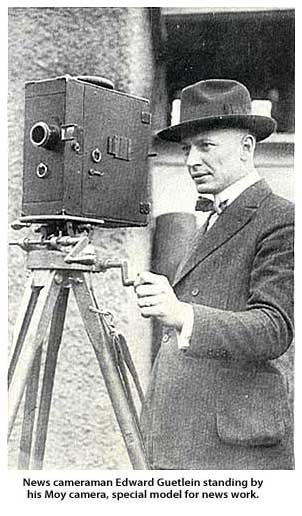
This first exhibition at Richmond, Indiana, could not be properly termed a public exhibition, as no admission fee was charged, but he followed this with a public exhibition in August 1895 at the Cotton States Exposition in Atlanta, Georgia. So incredulous were the people at the exposition that less than one hundred persons could be induced to pay an admission fee of twenty-five cents to see motion pictures – a word which had not then been coined. The ballyhoo, or announcer, failed utterly to convey to the minds of the passing populace what they would see in the exhibit. Finally, in desperation, he decided to invite the crowd to enter for nothing, and after the show was given, it was explained from the platform that those who so desired, might deposit a coin in the ticket box as they went out.
The interest aroused by those who saw the exhibition was such that it promised to be a success, but just as the young inventor had commenced to spend in his imagination the money he would make, a fire broke out in one of the neighboring concessions, destroying not only the exhibition hall, but a number of buildings surrounding it.
Between the time of exhibiting the pictures in Richmond, Indiana, and the unfortunate catastrophe at Atlanta, Jenkins formed a partnership with another young man, Thomas Armat, who had worked with him in building the two projecting machines, which they took to the fair at Atlanta. Armat’s father was a manufacturer of some means, so Armat was able to continue his experiments while Jenkins was compelled, for financial reasons, to return to work in the Treasury department. Jenkins’ inability to devote his entire time to experimentation resulted in a breach between the co-workers, which finally resulted in a number of legal controversies, which dragged through the courts for a long time.
Discouraged by lack of popular interest in his projection machine, Jenkins came to believe that it was of interest only to scientific bodies, and on December 18th, 1895, read a paper before the Franklin Institute of the state of Pennsylvania, in which he described and showed in detail the working of the Phantoscope.
Meantime, Armat, working independently made another machine, which he showed to Raff and Gammon, a firm largely interested in the penny peep shows prevalent at that time. They were the agents for the Edison coin-controlled Kinetoscope, which exhibited to one person only. Raff and Gammon did not display much interest in the Armat machine until the next year, when Jenkins set up his machine in a hall at Atlantic City directly opposite a pee-hole show. The managers of the slot machine arcade complained to their principals in New York, who investigated the cause for the falling off of patronage. People found it much more comfortable to sit in an orchestra chair and watch the pictures on the screen than to stand in an awkward position at the peek-hole of a slot machine. This stimulated Raff and Gammon to a new interest in the Armat machine, for although Edison had been working upon a projector, he had abandoned it for other matters. Raff and Gammon, therefore, made arrangements to have the Armat machine, which was copied from Jenkins’ original model, manufactured in the Edison shops to be put out as the Edison Vitascope. The following letter form Raff and Gammon to Armat shows how the original Jenkins’ invention came to be known as the Edison machine:
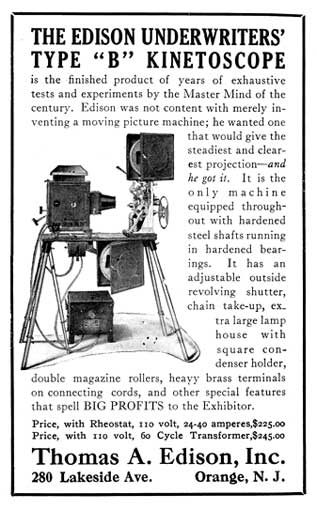
Kinetoscope and phonograph men and others have been watching and waiting for a year for the announcement of the perfection of the Edison machine which projects kinetoscope views upon a screen or canvas. No matter how good a machine should be invented by another, and no matter how satisfactory or superior the results of such a machine invented by another might be, yet we find the greatest majority of the parties who are interested and who desire to invest in such have been waiting for the Edison machine and would never be satisfied with anything else, but will hold off until they find what Edison can accomplish. We find that many of these parties have been approached in the last few months to invest in other similar machines, but they hesitate to do so, evidently believing that Edison would in due time perfect and put out a machine which would cast the others in the shade.
This being the case, you will readily reach the same conclusion that we have – that in order to secure the largest profit in the shortest time it is necessary that we attach Mr. Edison’s name in some prominent capacity to this new machine. While Mr. Edison has no desire to pose as inventor of this machine, yet we think we can arrange with him for the use of his name and the name of his manufactory to such an extent as may be necessary to the best results. We should, of course, not misrepresent the fact to any inquirer, but we think we can use Mr. Edison’s name in such a manner as to keep within the actual truth and yet get the benefit of his prestige. The machine might be made with a place upon which we could inscribe the words “Armat Design” or something of that kind, and you understand that after we have disposed of our territory and the business is fully established, and we have reaped the respective rewards, we will then make it our business to attach your name to the machine as inventor, and we are confident that you will eventually receive the credit which is due you for your invention. We regard this as simply a matter of business, and we trust that you will view it strictly in this light.”
Jenkins and Armat, before their dissention, had made a joint application for patent, which had not yet been issued on account of the friction between them. Armat, in order to clear the situation between them, offered to buy Jenkins interest in the joint application, and finally induced him to accept twenty-five hundred dollars in cash for his interest. Having disposed of his principal asset in the infant industry, Mr. Jenkins turned his major attention to other inventions, and ceased to be a factor in the game until recently he entered extensively into the manufacture of projecting machines and also organized the Society of Motion Picture Engineers.
Having thus briefly reviewed the early history of the motion picture up to the point where the first crude projectors of the present type were evolved, we will leave this subject to pass on to present-day practices. To give even a skeleton synopsis of the development of the industry from that time to this would fill several volumes the size of this. The student who wishes to delve into the past can consult the many books mentioned in the bibliography and the bound volumes of motion picture periodicals in the libraries.
CHAPTER II – FASCINATION OF CINEMATOGRAPHY
Motion pictures cover a field that is almost universal, and the person who is skilled in taking pictures with the cinematograph camera, or interested in any of the pursuits intimately connected with its operation, practically has an unlimited field in which to exercise his creative energy.
Wanderlust, the desire to see strange countries and foreign peoples, is a longing which many possess, but few are able to satisfy. Many a man with a longing to travel and see the far stretches of the world has been able to pay all the expenses of his globe-trotting, and pocket a bonus, by taking along a motion-picture camera and bringing back to his less fortunate friends an interesting intimate reproduction of the sights and scenes which have held his interest during his journey.
The making of dramatic pictures covers a field of ever varying novelty that is the very antithesis of monotony.
There is scarcely a trade or profession in which cinematography has not important and direct relation to its improvement and expansion.
There is no doubt that by the aid of the motion picture, the duration of the great world war was very considerably shortened. In no other way could the tremendous amount of propaganda and information concerning the war situation have been made clear to the populace. The committee on public information, in conjunction with the government, sent out thousands upon thousands of feet of motion picture film, showing the activities of the government and of the army and navy. All of the allied war charities attribute their ability to raise tremendous sums for philanthropic purposes mainly to the agency of motion pictures. Thousands of men and women were engaged in making propaganda films of all kinds. The war loan committee, aided by the motion picture industry, made thousands of feet of film to stimulate the loan drives.
In educating and training our army and navy, the motion picture was of incalculable value. So remarkable have been the results achieved in the training of men by the use of motion pictures that it is freely and confidently predicted that tremendous and important as is the production of motion pictures for amusement and entertainment purposes, in a comparatively short time to come that use will be relegated to a position of insignificance in comparison with the tremendous production of motion pictures for educational and pedagogical purposes.
In the making of these pictures, thousands of craftsmen have yet to receive their training. The government of the United States, realizing the tremendous importance of motion pictures as an educational factor, is establishing a bureau in Washington for the production and distribution of educational pictures to be used by schools, churches colleges, community organizations, and welfare units. The film manufacturers, who have hitherto been blind to the educational possibilities and the financial opportunities presented, are now eagerly seeking to make up for lost time and are hastening their preparations to supply the rapidly growing demand for this kind of picture.
“Educational” is a much abused word, which, in the past, generally meant to the exhibitor and show-man, a scenic picture or an industrial picture of haphazard construction, which, more often that not, acted as a chaser to drive people from the theatre. Gradually, producers of scenic, industrial, and educational pictures came to realize that unless their product was made with the same care, as or even greater care, than that devoted to the production of dramatic pictures, they could not continue to exist. Today, people of specialized training in nearly every profession are being employed in the studios and laboratories of producers of educational pictures in order to make them more interesting and instructive.
Thousands of manufacturers are using motion pictures to instruct and amuse their employees, and have found in them one of the most powerful antidotes for labor troubles and social unrest. In no other manner can the destructive conditions caused by labor troubles be so forcibly and favorably impressed upon the mind of the workers.
All of this is quite aside form the use of motion pictures for the advertisement and exploitation of the manufacturer’s production. Here is another avenue for the disposal of the product. One of the greatest problems in connection with the demonstration of large and not easily portable pieces of machinery has been that the customer could not see these machines in operation. Today the manufacturer’s salesman can carry a portable projection machine, less heavy and cumbersome than a well-packed suit-case, with a reel or reels of film, with which he can demonstrate upon the walls of his customer’s office all of the possibilities of which the machine is capable, with far greater brevity, and often, with greater clarity than he could demonstrate the actual machine in operation. By means of close-up views, enlargements, and animated diagrams, he can show details and features that could not be demonstrated even by the operation of the machine itself.
For the production of pictures of this kind, thousands of camera and laboratory and technical workers must be trained. Authors of industrial scenarios, directors, who understand the intricacies of complicated machinery and of industrial and manufacturing processes; camera operators, who can photograph the things which the directors wish to show; title writers and film editors for placing the photographer’s scenes in logical and interesting continuity; laboratory workers to turn out prints of the highest photographic quality, tinted and toned in attractive colors; all are needed for this rapidly growing industry.
The film reporter, gathering the topical news of the day with his motion picture camera, lives a strenuous but intensely interesting life. He must be ready at a moment’s notice to take his grip and motion picture outfit and travel to any point on the globe to feed the insatiable appetite of the news-loving public for minute details of the latest event. In the larger cities, the big theatres are slow indeed, if they do not throw upon the screen on the same day that it happens, any event of importance taking place within two or three hours’ ride of the city.
Besides the news events, thousands of short subjects of more general interest have brought the Animated Screen Magazine into existence. In the same way that the animated newspaper satisfies the curiosity of the public for the latest news, the screen magazine treats all the latest topics of the day in much the same manner as the popular magazine. It has this advantage over the magazine, compelled to confine itself to cold type and still pictures; it can show operations, movements, and animated diagrams in a few seconds’ time, that page of print could not half so adequately explain.
It is obviously that this branch of the business must fall largely into the hands of the unattached or independent worker, who bears the same relation to the picture theatre as the outside correspondent to the newspaper. A firm engaged in supplying news films cannot hope to succeed without amateur assistance. No matter how carefully and widely it distributes its salaried photographers, numberless events of interest are constantly happening – shipwrecks, accidents, fires, sensational discoveries, movements of prominent persons, and the like, at places, beyond the reach of the retained cinematographer. For film intelligence of these incidents the firm must rely upon the independent worker.
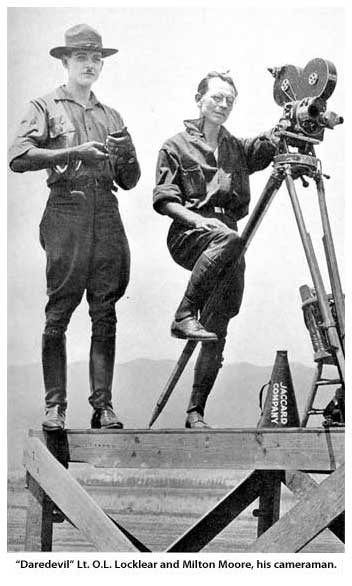
Curiously enough, in many cases, the amateur not only executes his work better than his salaried rival, but also often outclasses him in the very important respect that he is more enterprising. Acting on his own responsibility, he knows that by smartness alone can he make way against professionals. Only by being the first to seize the chance can he find a market for his wares. Thus when Bleriot crossed the English Channel in his aeroplane it was the camera of an amateur that caught the record of his flight for the picture theatres, although a corps of professionals was on the spot for the purpose. True, the successful film showed many defects. But defects matter little compared with the importance of getting the picture first or exclusively. Plenty of similar cases exist. The amateur has an excellent chance against the professional. His remuneration, too, is on a generous scale. The market is so wide and the competition so keen, especially in New York, the world’s center of the cinematographic industry, that the possessor of a unique film can dictate his own terms and secure returns often twenty times as great as the first cost of the film he has used.
Aside from the wide field of entertainment to which most of the products of the motion camera are devoted it is daily broadening its scope in the field of scientific investigation. Technical laboratories are daily finding new and diverse problems in the solution of which the cine camera plays an important role.
Scientific research has received a mighty and tremendous impetus in this country through the conditions arising from the great world conflict. We are just beginning to realize how dependent we have been in allowing foreign brains to solve for us the great bulk of the more complex industrial processes and the awakening finds us determined and able to take and retain the leadership in this important task.
Efficiency means the elimination of waste – one of our greatest wastes is time waste; every excess movement wastes a precious interval of time; the cine camera has become a detective, sleuthing out the thieving excess motion which steals valuable time.
Frank Galbraith, a noted efficiency engineer, has, by the use of motion pictures, succeeded in eliminating false and useless motions to such an extent that various factory operations have been speeded up so the output has been increased as much as three and four hundred per centum. Marvelous as it may seem, the worker was able to turn out this increased amount of work with much less fatigue than when he had done a less amount under the haphazard regime.
When the motion camera is used for time studies, a split-second clock is generally placed in the picture and photographed at the same time, thus giving an accurate record of the time interval between each frame or picture on the celluloid tape.
Percy Haughton, the Harvard football coach, has adopted the motion camera for revealing the faulty and unnecessary motions of players on the football field. Every fraction of a second gained on the athletic field is a big boost toward victory.
A picture released about a year ago by one of the large companies excited much comment and illustrated how motion pictures may prove of great service in correcting faulty muscular action. The picture showed an athlete in various simple gymnastic feats such as walking, running, jumping and shot putting, taken simultaneously with two cameras. One camera took the action at the ordinary rate of sixteen pictures per second, while the other camera made one hundred exposures to the second; the normal and the ultra-speed pictures were projected one after the other at the normal rate of projection thus prolonging or amplifying the ultra film to nearly six times the duration of the normal motion. It was very weird and interesting; the ease and deliberation of the prolonged action gave time for the study of every movement and the play of every muscle. One could not help but marvel at the co-ordination of the work of the muscles. The figure of the athlete seemed like a diver immersed in crystal clear water, the buoyancy of which floated him through the graceful attitudes of his movements.
As ordinarily shown, motion pictures are taken and projected at the rate of sixteen pictures per second, but for the scientific investigator the rate of speed may vary from as high as 30,000 to the second in the study of high speed phenomena to as low as one exposure per hour or even one exposure per day, as used in studies in the change of structural materials, or the growth of a plant. All of these may be projected at normal speed for screen study or each frame may be subjected to individual scrutiny under the magnifying glass in special cases as in seeking to eliminate lost motions in machine assembly, etc.
Reduced to normal projection speed, bullets swim across the screen like leisurely fish and bursting shells separate like a group of mosquito wrigglers. Many high speed processes, such as the flow of steam; air and gases; combustion and explosions; automobile engines; the action of governors; the synchronism of electric generators; the flow of water in turbines and water wheels; the action of steel and wood-working machinery; and machine tools; etc., may be photographed at high speed and slowed down in projection so that they may be studied with the greatest accuracy.
Historic Photographs of Motion Picture Photography in the 1920’s.
(click on images to enlarge)
